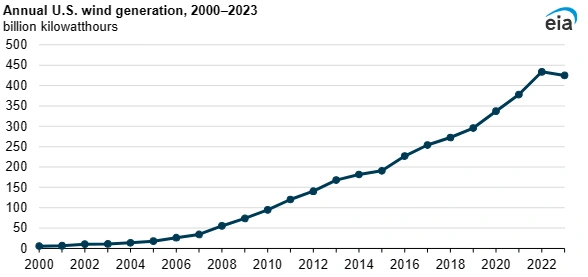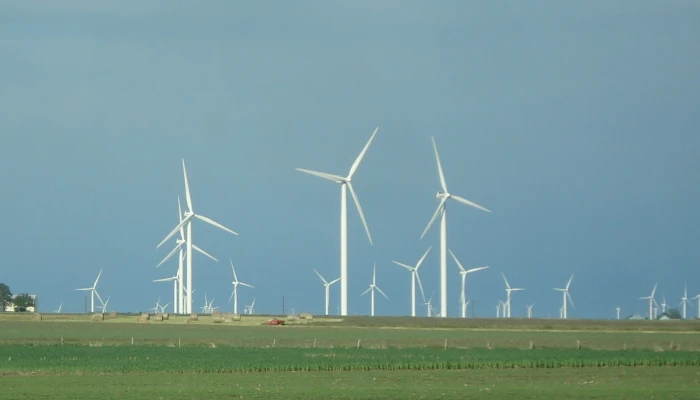Renewable Energy Challenges and the Unforeseen Decline in Wind Power
Illinois had laid out ambitious plans to champion renewable energy as the heir apparent to coal in its energy strategy. However, 2023 unfolded with unexpected twists, as natural gas stepped into the spotlight, filling the gap left by the diminishing coal industry, despite the state’s commitment to wind and solar power.
Electricity generation from renewable sources faltered last year, contrary to the expectations set by Illinois and its Midwest neighbors. The push to phase out fossil fuels like coal and natural gas in favor of cleaner alternatives faced unforeseen hurdles, potentially complicated by the effects of climate change.
In a startling shift, wind power, which has been Illinois’ leading source of renewable energy, saw a 6% reduction in electricity generation compared to the previous year. Conversely, the production of electricity from natural gas surged by 43%, propelled by the operational commencement of the Three Rivers Energy Center, a 1.2-gigawatt gas-fired power plant in Grundy County.
Jessica Conroy, an associate professor of earth science and environmental change at the University of Illinois, sheds light on the situation: “Small changes in wind speed can have pretty consequential impacts on wind power.” Conroy, alongside doctoral student Allison Wallin, is delving into the variations in wind speeds over the past three decades to forecast future trends and their implications for wind energy.
“Using future model wind projections is a real necessity,” Conroy emphasized, highlighting the increasing need to adapt to changing wind patterns influenced by global climate shifts.

The peculiar behavior of the winds last year was largely attributed to a robust high-pressure system in Canada. This system, which also exacerbated wildfires that clouded Chicago skies with smoke, played a significant role in diminishing wind speeds across Illinois. “For much of the early months of summer, winds blew from east to west, which is opposite of the typical pattern of west to east,” noted Illinois State Climatologist Trent Ford, explaining the unusual meteorological conditions.
The average wind speed at O’Hare Airport from June to August 2023 dipped to 8 miles per hour, marking the lowest since 2009 and significantly below the norm for the past two decades. This anomaly has prompted further investigation into the broader impacts of climate change on wind speeds, which vary naturally but have shown a concerning deceleration over time.
Despite the setbacks in wind power generation, solar energy has emerged as a burgeoning force in Illinois, albeit from a modest base. Solar power’s contribution to the state’s electricity grid grew significantly last year, reflecting a potential pivot towards this more consistently reliable source of clean energy.
The state remains steadfast in its goal to eliminate fossil-fuel power by 2050, a vision supported by recent energy legislation that not only rescued aging nuclear facilities but also boosted incentives for solar and wind development.
Yet, the reliance on renewable sources introduces a new layer of variability in power generation, contingent on the whims of weather and climate patterns. Michael Craig, a University of Michigan professor, advises long-term planning: “For a system planner, you have to think not just about one weather year, but about many weather years—10, 20, even 30—so you can capture enough of that variability before you make your investment decisions.”
More To Discover
- New Swedish ‘Electric Soil’ Boosts Barley Growth by 50% in 15 Days
- Setback for US Offshore Wind Ambitions as Orsted Halts Major Projects Citing Economic Pressures
- Climate Change Rolls Back Decades of Clean Air Progress in U.S., Study Reveals
- How Media’s Single-Use Mask Bias Contributed to PPE Pollution During The Pandemic
Public perception and industry responses to these fluctuations remain optimistic, according to Jeff Danielson, vice president of advocacy for Clean Grid Alliance. It’s important that people keep in mind that one year does not a trend make,” he remarked, reinforcing the sentiment that the journey towards a renewable future, though fraught with challenges, is still on course.
As Illinois navigates the turbulent waters of energy transition, the state, researchers, and advocates remain vigilant, continuously adapting strategies to harness the power of nature—both the wind and the sun—to fuel its ambitious environmental goals.





















